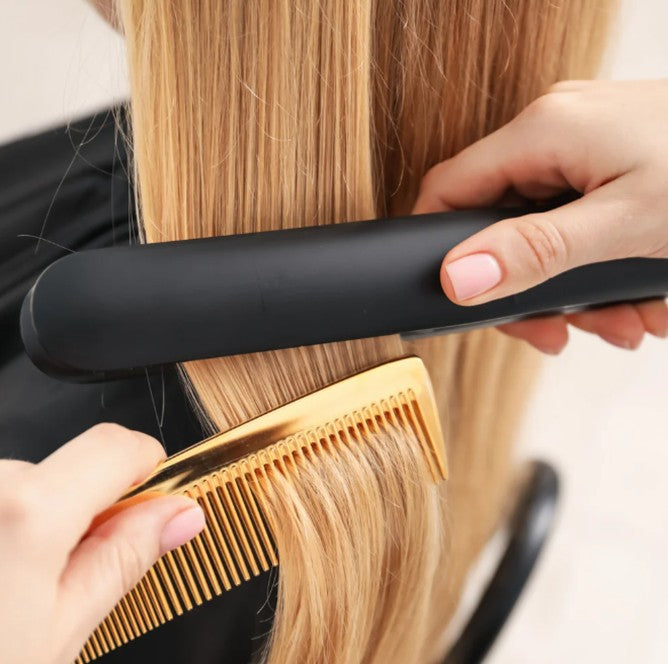Hair Elasticity 101: Why Is My Hair Stretchy?
by BRENDA L. / FEB 10, 2023

Reading Time: 7 Minutes
Index
Because of its structure and the deceiving language that we hear in commercials and on the back of certain products, more often than not we are pushed to believe that hair is not meant to be stretchy at all – but this couldn’t be further from the truth. On the opposite, though, if your hair is excessively stretchy, this could be a sign that your strands are not as healthy as you may think: read on to find out more about hair elasticity and its optimal state!
1. What Does It Mean If Your Hair Is Stretchy?
Depending on the level of elasticity that we’re talking about, if your hair's a little stretchy, this is usually nothing to worry about. Quite the opposite, it is an indicator of your strands being correctly moisturised and retaining hydration! Your hair retains moisture in its cortex, aka the inner layer underneath the cuticles. This allows your strands to maintain that natural bounce and movement necessary to allow your hair to stay flexible without snapping off at the first blowout. When your hair is damaged by overprocessing, chemical treatments and too much heat, the strands’ structure struggles in retaining such moisture – resulting in dryness, brittle hair and breakage. However, too much moisture can also become a problem – causing your hair to become dull and lifeless.
Elasticity in your hair is a good sign, but just like with moisture, too much of a good thing can be fatal for your hair’s health. If we’re talking about strands of hair that go like a rubber band when brushing, feeling gummy and snapping off, stretchy hair is telling you that your hair is damaged and needs help ASAP.
2. Why Is My Hair Elastic When Wet?
If, after a good shower, your hair feels gummy, mushy and stretchy, this could be the tell-tale sign that your mane is going through a hard time. This can also be confirmed after the drying stage, when instead your strands become dull and limp – lacking natural bounce and movement even during the “swaying hair” test, and laying flat on your head without any volume. Styling becomes a pain, as your hair won’t hold the blowout and you’ll feel forced to use heat-based tools at the highest temperature available – causing even more damage.
If you have curly hair, stretchy hair will alter the pattern of your natural curls, making them go looser and lifeless. So, how do you fix this?
3. How To Check Elasticity Of Hair?
Even after reading all of this, it might not be so obvious to you if your hair still has its elasticity game on point, I get it. Some people will be able to tell right away if their hair has gone too far in stretchiness, especially if under the shower your mane feels like melted chewing gum. If not, just follow these easy steps to find out if your hair is healthily elastic or sending a desperate SOS!
Step 1: Get Your Hair Wet
Making your hair wet is the first step to bring it down to its most fragile state – which allows you to test it at its worst. The ideal conditions to find out what your hair really needs!
Step 2: Separate A Small Strand
No need to examine your whole mane – just isolate a very small section.
Step 3: Hold It And Stretch
Hold the small section at the root to prevent any pulling on your scalp, then start to softly stretch it out – don’t pull from your ends, but do it from mid-length instead.
Step 4: Let Go
At this point, healthy hair will bounce back to its previous state – whilst overly-stretchy strands will take longer to do so; the worst cases won’t bounce back at all or could even snap off.
4. Does Stretchy Hair Need Protein Or Moisture?
Once you have established that your hair is too stretchy and needs some help to regain its natural shine and bounce, know that this ultimately comes down to the right protein-moisture balance. There are many different factors that affect this precious balance, such as: heat damage, excessive hair colouring, bleaching, perming, relaxing, and even over-moisturisation.
5. How To Get Hair Elasticity Back
In order to restore natural elasticity in your hair, there is something that you can do. Let’s find out together how to bring back your hair’s health!
Step 1: Use Repairing Products
Specific products such as the Olaplex Repairing Kit are designed to rebuild the bond in your hair and help it recover from the overprocessing. Whilst there is no miracle potion that can fully reverse the damage, this is the closest you can get to make your hair look and feel better. Olaplex’s patented formula repairs the hair’s structure from the inside, allowing it to get some of its original strength and bounce back.
Shop Now: Olaplex Repairing Kit
Step 2: Use Heat Protectant Spray
At this point it’s a given – you should avoid causing any more damage to your tresses, but when you can’t avoid using heat-based styling tools (including your blow-dryer), then make sure you apply a generous amount of Cliphair heat protectant spray on your mane. This will help dissipate the heat, sheltering your strands from further damage.
Step 3: Balance Out The Proteins
If you stocked up on moisturising products convinced that hydration in hair is everything, you made a rookie mistake. But don’t worry – you can still fix this! Hydration keeps your hair soft and malleable, but in order for it to resist pulls and tugs you’ll need to add proteins to strengthen your strads’ natural strength. Fortifying products are usually packed with proteins for your hair, so lookout for such products. A valid option that I highly recommend is Kérastase Discipline Bain Fluidealiste line, with its hydrolyzed keratin formula!
Shop Now: Kérastase Discipline Bain Fluidealiste
Step 4: Reduce Heat Damage
Nowadays there are many ways for you to reduce or even take down to zero the amount of heat that you apply on your hair. From flawless, heatless curls to the various techniques to air-dry your mane, all you need is the right accessories (and a bit of time). Find out more about this topic in our dedicated blog: Let It Breathe: How To Air-Dry Your Hair Like A Pro.
Interested in a blowout that is kind to your hair and looks as gorgeous as the one you’d get at the salon? Read everything you need to know in our post: Heatless Hair: Curl Ribbons & Silk Everything Are The Latest Trend.
Step 5: Wear Hair Extensions
Wearing hair extensions has been proven to be the solution for many hair problems: whether you have a mane that you’re trying to replenish with volume and bounce or simply have some texture and damage issues you’d like to minimise, real hair extensions are the perfect tool to give your hair a kick of glamour and beauty whilst you wait for it to regain its natural shine and strength.
Step 6: Get A Haircut
There’s no way to sugarcoat this, if your hair has gone beyond repair you’ll need to chop off a good portion of it. Keep your trims regular and, in the meantime, you can use solutions such as hair extensions to get your volume and length back. Depending on your desired hairstyle and your hair type, there are many options for you! Clip in hair extensions are perfect for you to switch in between hairstyles from short to long, whilst tape in hair extensions are a longer-lasting solution for those who like to wear their hair down, long and flowy.
6. Conclusion:
If your hair has gone a little too stretchy, balancing out hydration and proteins in your hair’s structure will help you fix things. Keep an eye on your usage of heat-based styling tools and explore Remy hair extensions as a solution for you to give your mane body and thickness even when your natural hair is struggling!
Looking for flawless, salon-worthy hair without breaking the bank? At Cliphair, we’ve got you covered with luxurious clip in hair extensions for quick transformations and permanent hair extensions for long-lasting glam. Extensions require special care and maintenance to preserve their quality, which is why we have all the top-notch hydrating haircare products needed to keep your style on point.
Need the perfect shade? Browse our full range of human hair extensions in over 70 rich, silky shades or check out our FREE Express Color Match Service to ensure a seamless blend every time.







